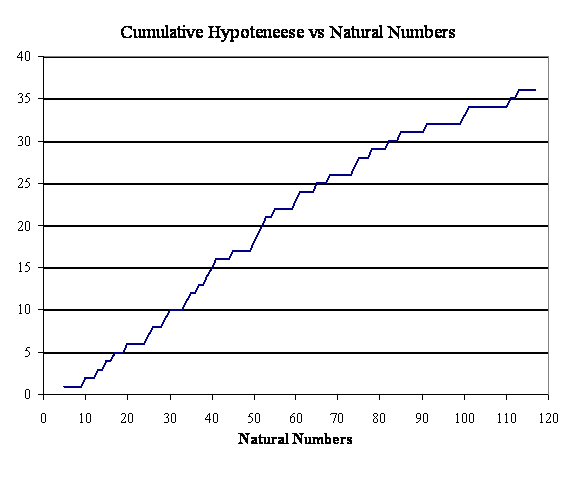 he
puzzle
asks for the formula that generates a family of right
triangles having
the indicated Natural Hypoteneese
starting
with 3|4|5, 5|12|13, 7|24|25, 9|40|41. Two
observations: he
puzzle
asks for the formula that generates a family of right
triangles having
the indicated Natural Hypoteneese
starting
with 3|4|5, 5|12|13, 7|24|25, 9|40|41. Two
observations:
-
The smaller side
is apparently any
odd integer starting with 3. Let x
= 2n +1.
-
The hypotenuse
is one larger than the
larger side. Thus, h = y
+ 1.
The challenge comes
down to figuring
out the value of y as a function of n.
The
expression "figuring out" ranges in meaning from
foozling to formally
deriving. In this case, some guessing, with the
help of a spreadsheet,
comes up with y = 4 n&
(pronounced "n totorial,"
as introduced in Roulette's
Frets). Since
n&
= n(n +1)/2, y =
2n(n+1).
The solution, then, is given by...
|
x
= 2n
+1
|
y
= 2n(n
+
1)
|
h
= y
+ 1
|
You might enjoy proving that these
formulas work for all
values of n...
[2n
+1]2
+ [2n(n + 1)]2
= [2n(n + 1)
+1]2
You might also enjoy exploring the
question of how many
Natural
Hypoteneese there
are. Well, of course,
there is an infinite number -- in each family.
Still, there are plenty
of integers that are not Natural Hypoteneese.
The graph below shows the cumulative Natural
Hypoteneese in relation
to the natural
numbers.

 ur
old friend the "three|four|five triangle" is the first
triangle shown and
has its natural hypotenuse placed in the lower left of
the graph corresponding
to natural number 5.
The line
rises gradually, going flat along the way indicating
natural numbers that
cannot qualify as Natural
Hypoteneese.
At natural number 55, we see an
accumulation of 22 Natural
Hypoteneese, for a ratio
of 40%. That's
as large as it gets! Excuse the
exclamation point. At
natural
number 110, the ratio has fallen to 29%.
What do you suppose
the asymptote might be? ur
old friend the "three|four|five triangle" is the first
triangle shown and
has its natural hypotenuse placed in the lower left of
the graph corresponding
to natural number 5.
The line
rises gradually, going flat along the way indicating
natural numbers that
cannot qualify as Natural
Hypoteneese.
At natural number 55, we see an
accumulation of 22 Natural
Hypoteneese, for a ratio
of 40%. That's
as large as it gets! Excuse the
exclamation point. At
natural
number 110, the ratio has fallen to 29%.
What do you suppose
the asymptote might be?
You are invited to send your favorite
observations about
Natural
Hypoteneese here.
|

![]()